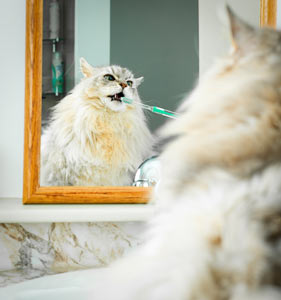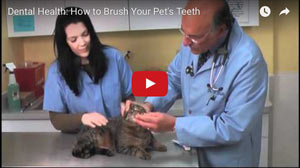Home Dental Care for Cats

Cat teeth are similar to human teeth. They have the same system of enamel, nerves, blood vessels, and ligaments. Imagine how your teeth would look and feel if you never brushed them. That is exactly what happens to your cat's teeth, because cats don't brush and floss daily. First, the teeth become covered with plaque, which is saliva mixed with bacteria. If the plaque isn't removed from the tooth, it mineralizes and becomes tartar. Tartar allows strains of bacteria that are exceptionally destructive to teeth to invade the mouth.
Negative Outcomes of Dental Disease in Cats
Good dental health is an important factor in your cat's overall physical condition and well-being. Dental disease in cats can be detrimental to nutrition, general health, and quality of life. The list below highlights some long-term consequences of poor feline dental health.
- Bad breath (halitosis) is often a result of dental disease, and it can negatively impact your relationship with your cat.
- Dental abscesses (the formation of pus in the teeth or gums) are painful and often require surgical removal of teeth.
- Tooth loss may result from the destruction by bacteria of the periodontal ligament that anchors the tooth to the underlying jaw bone.
- Infections starting in the teeth and gums can spread through the bloodstream and become systemic, negatively affecting your cat's kidneys, liver, heart, or lungs.
- Avoiding repeated dental treatments, anesthesia, tooth extractions, and surgeries is beneficial because these things can be expensive for you and stressful and uncomfortable for your cat.
The good news is that, by caring for your cat's teeth on a daily basis, you can greatly reduce or even entirely avoid these negative scenarios.
Supplies Necessary for Caring for Your Cat's Teeth
First, it's always a good idea to take your cat to a veterinarian for an initial dental health assessment. Your cat may need a professional cleaning before you start a home care regimen. Your veterinarian can also advise you about your cat's dental risk factors, products you should use, and even show you how to brush your cat's teeth.
Once you get the go-ahead from your veterinarian, the next step is finding products that work well for your cat. Be patient, as this can require some trial and error.
- Cat toothbrush: There are a variety of cat toothbrushes on the market. Look for one with a small, angled head and soft bristles. There are even toothbrushes that fit over your finger. These give you better control, but their soft latex bristles may be less effective at mechanically removing tartar. You can try both types out by betting this Oral Hygiene Kit for Cats.
-
Cat toothpaste: Use only dental products that are made for cats. Do not use human toothpaste. The strong flavorings are very unappealing to cats, and the fluoride and other ingredients could be harmful when your cat swallows them. Human toothpastes, including natural ones, also often contain xylitol. This chemical is extremely toxic in dogs. Its effects in cats aren't as well-documented, but it is prudent to avoid exposing them to it.
Cat toothpastes are safe to swallow (since animals don't rinse) and are made in feline-friendly flavors like chicken, fish, and tuna. Some contain enzymatic agents to help break down the tartar.
- Dental treats: While not a substitute for brushing, some dental treats can help reduce the rate of tartar buildup on cats' teeth. Give these treats to your cat as rewards and also for routine dental hygiene. Not all over-the-counter dental treats are created equal. Ask your veterinarian for recommendations.
Steps to Successfully Brushing Your Cat's Teeth
- Get your cat get used to having your fingers near and eventually touching her mouth. If this is new for your cat, you may need to proceed at a very gradual pace.
- Acclimate your cat to the toothpaste and brush. Start by letting her lick the toothpaste off your fingers. Next time, use your cat toothbrush and, again, encourage your cat to lick the toothpaste off the brush. At this point, your cat may begin to look forward to this yummy treat, so it's not a bad idea to brush your cat's teeth around the same time every day.
- When it's time for the real thing, position your cat on a counter or your lap, hugging gently with your forearms so as to minimize squirming and maximize access to the mouth. Start by lifting your cat's upper lips and sliding the brush in a fine circular motion along the gum line. Focus on the front teeth first, then the back teeth if you can. Do the upper teeth first, then the lowers. Brush outer tooth surfaces only (if you want to keep your fingers, that is) because cats don't build up much tarter on the inside surfaces of their teeth. As you and your cat become more comfortable with the procedure, work towards reaching the upper back molars. This is usually where plaque builds up the most. The entire process should take about one minute once you and your cat get the routine down.
- Follow every tooth-brushing session with enthusiastic praise, petting, or playtime; whatever your cat appreciates most. You may also give her a dental treat. Reward your cat no matter how far you get into the brushing process. Over time, this procedure will become a habit; something that you and your cat can even enjoy . . . and smile about.
Dr. Schelling's Helpful Hints:
- Relax. If you're tense, your cat will immediately sense it. If you approach the process calmly, your cat may, too.
- Baby steps. Introduce this routine in small increments. Your cat will thank you for taking it slowly.
- Perfection is not required. Although daily brushing is recommended, any amount is better than none.
- Start now. It's never too late to begin caring for your cat's teeth, though creating the habit during kitten-hood is ideal.
For more tips watch this great video tutorial on brushing your cat's teeth.

You May Also Like These Articles:
Wet Food vs. Dry Food For Cats
Notice: Ask-a-Vet is an affiliated service for those who wish to speak with a veterinary professional about their pet's specific condition. Initially, a bot will ask questions to determine the general nature of your concern. Then, you will be transferred to a human. There is a charge for the service if you choose to connect to a veterinarian. Ask-a-Vet is not manned by the staff or owners of CatHealth.com, and the advice given should not delay or replace a visit to your veterinarian.






